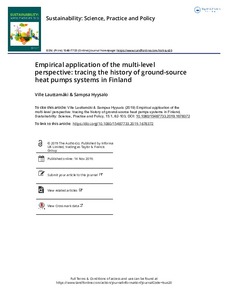Empirical application of the multi-level perspective: tracing the history of ground-source heat pumps systems in Finland
Ville Lauttamäki; Sampsa Hyysalo
https://urn.fi/URN:NBN:fi-fe2021042826622
Tiivistelmä
The emergence and evolution of more sustainable technologies and related industrial fields
is a core concern for sustainability transitions scholars. This interest is accentuated as it has
become evident that the upscaling of transition-relevant technologies follows different pathways
in varying national and geographic contexts. The usual research approach to studying
such industry-field dynamics in particular contexts has been to use the technological innovation
systems (TIS) framework, focusing on the emergence of functioning TISs. The current
calls for life-cycle TIS and the few existing examples of operationalizing the multi-level perspective
(MLP) in a more focused way underscore the need to better account for the contextual
specifics, contingencies, and later phases in the proliferation of transition
technologies. We elaborate on the benefits of using the MLP in long-term analyses of transition
technologies by examining the history of ground-source heat pump (GSHP) systems in
Finland from the era of the energy crises in the 1970s until the present day. The investigation
reveals how the present success of GSHPs has not followed just from simple innovation-
system dynamics or niche-regime landscape relations but is also a result of variations
and extent of landscape pressure as well as unplanned support from neighboring niche
technologies.
Kokoelmat
- Rinnakkaistallenteet [19207]
